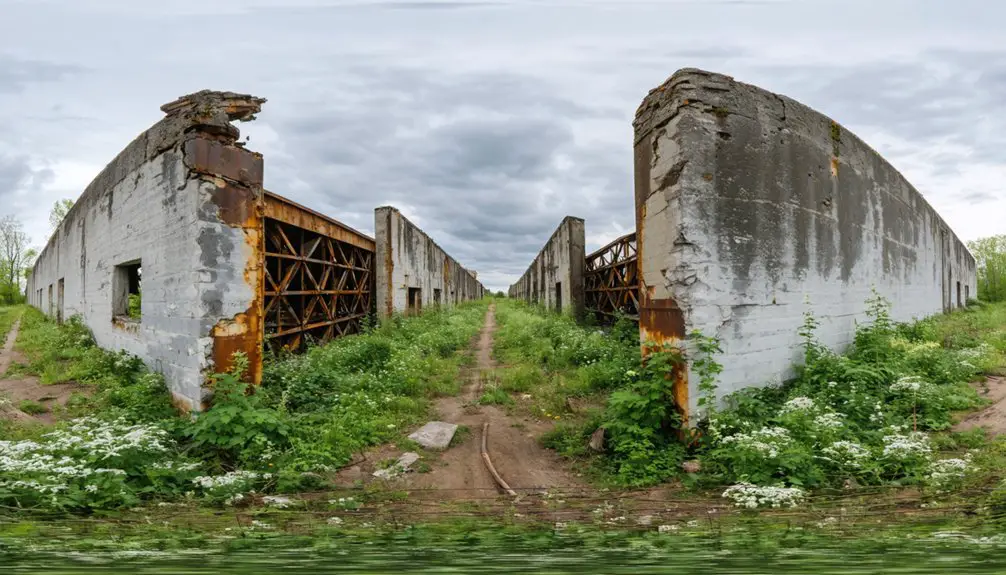You’ll find Fiborn Quarry in Michigan’s Upper Peninsula, where limestone mining thrived from 1905 to 1936. The self-contained company town boasted worker housing, a store, school, and boarding house, all centered around the quarry’s bustling 480-acre operation. While the Great Depression ultimately forced its closure, today you can explore the preserved concrete ruins from May through October, where nature slowly reclaims this once-prosperous industrial community’s remnants.
Key Takeaways
- Fiborn Quarry operated as a limestone mining town from 1905 to 1936 in Michigan’s Upper Peninsula before becoming abandoned.
- The self-contained company town included worker housing, a store, school, and boarding house controlled by quarry operators.
- The Great Depression and competition from Rogers City’s limestone caused the quarry’s decline and eventual abandonment in 1936.
- Concrete ruins of sorting bins, powerhouse, railroad facilities, and building foundations remain visible at the abandoned site.
- The Michigan Karst Conservancy now manages the ghost town site, offering public trails from May through October.
The Birth of a Mining Community
While exploring Michigan’s Upper Peninsula in 1898, Chase Osborn discovered a promising limestone range in Mackinac County that would soon become Fiborn Quarry. Partnering with railroad executive William Fitch, Osborn’s initial land speculation venture evolved into a full-scale mining operation by 1904 when they uncovered high-grade karst limestone deposits. A boarding house that served as a town hall meeting place provided a central gathering spot for community events.
The community dynamics took shape as workers and their families settled into the company town, which you’d find equipped with essential amenities like a company store, post office, and school. By 1927, the quarry town reached its height with 75 men working at the bustling operation.
Life in the Company Town
Like many company towns of the early 1900s, Fiborn operated as a self-contained community under the tight control of its quarry operators.
You’d find your daily life revolving around the company’s schedule, from the warning whistles before blasting to the strictly regulated four hours of evening electricity for lighting only. The company culture touched every aspect of life – they owned your housing, ran the only store, and controlled the sole telephone in town. The twenty students attended the local school which offered education through seventh grade. Women found employment as cooks and housekeepers at the boarding house.
Yet despite these restrictions, you’d discover a close-knit community spirit centered around the boarding house.
This hub hosted everything from church services with traveling ministers to lively dances and town meetings. Community events brought together the 75 workers and their families, creating bonds that helped residents thrive despite their isolated location and company-controlled existence.
Limestone Legacy and Economic Impact
You’ll find the story of Fiborn Quarry’s economic impact written in its high-grade limestone, which created substantial wealth for Michigan’s Upper Peninsula through rail shipments to Algoma Steel and other industrial buyers.
The facility featured a robust high-calcium limestone operation spanning 480 acres, enabling large-scale mineral extraction. The quarry’s strategic rail connection to Sault Ste. Marie enabled efficient transport of crushed stone across the region, powering both American and Canadian steel production throughout the early 1900s. Like many limestone operations of its time, the facility relied on the Detroit and Mackinac Railway to deliver its valuable mineral resources.
Fiborn’s prosperity couldn’t withstand the Great Depression‘s brutal economic pressures, as cheaper limestone sources ultimately forced the quarry’s closure in 1936.
Mining Wealth Creation
Mining profits from the quarry’s exceptionally pure limestone fueled regional growth, primarily through its essential relationship with Algoma Steel Corporation and the creation of a self-sustaining company town.
You’ll find evidence of community resilience in these key economic impacts:
- Creation of important jobs supporting entire families through direct employment and related sectors like lumber.
- Development of extensive town infrastructure including housing, schools, electricity, and a company store.
- Establishment of a strategic mineral resource that positioned Michigan’s Upper Peninsula as a significant industrial supplier.
The quarry’s economic influence extended beyond simple resource extraction, creating a thriving micro-economy that sustained workers and their families throughout the early 20th century.
Operating on a rigorous ten-hour workday schedule, the quarry maintained steady production levels that helped stabilize the local economy.
The remote location of the quarry eventually led to its decline by 1936 as competition from more accessible operations grew stronger.
Rail Transportation Economics
While mining operations generated wealth through limestone extraction, the economic impact of Fiborn Quarry hinged on its sophisticated rail transportation network.
You’ll find that the 1904 standard-gauge railroad branch connected to the DSS&A line was essential for the quarry’s success, enabling transportation efficiency that could handle 1,500 tons per hour after 1911.
The rail logistics system wasn’t just about moving stone – it transformed Fiborn into a significant economic hub.
You’re looking at a network that connected the remote quarry to major industrial centers, including Algoma Steel in Sault Ste. Marie, Ontario.
This transportation backbone supported not only the 75 quarry workers and their families but also sustained the entire company village through efficient limestone distribution to steel manufacturers and construction industries across the region.
The economic challenges became evident when low demand forced intermittent closures between 1921 and 1923.
Depression’s Fatal Blow
Despite the quarry’s exceptional limestone quality and established industrial presence, the Great Depression delivered a devastating blow to Fiborn’s operations between 1930 and 1936.
You can trace the quarry’s decline through three key developments:
- Algoma Steel’s drastically reduced limestone demand crippled the quarry’s resource management strategy.
- Operations scaled back to bare minimums by 1933, barely keeping the village infrastructure alive.
- A brief, desperate revival attempt in January 1936 proved futile against market forces.
The quarry’s sustainability became impossible as cheaper limestone sources emerged and industrial buyers vanished.
When the operation permanently closed in early 1936, it marked the end of an era for the once-thriving company town, leaving behind empty buildings and silent machinery as evidence of the Depression’s unforgiving economic impact.
Challenges and Eventual Downfall

You’ll find the Fiborn Quarry’s trajectory took a sharp downturn during the Great Depression, when nationwide economic pressures severely impacted limestone demand.
The quarry’s shift from rail to ship transport in the late 1920s, while initially cost-saving, ultimately proved problematic as changing logistics disrupted established supply chains.
These economic strains, combined with declining revenue and an inability to maintain its workforce, pushed the operation toward its closure in 1935.
Both the quarry and post office halted operations in 1935, marking the beginning of the town’s complete abandonment.
Economic Pressures Mount
As the post-World War I recession hit in 1921-22, Fiborn Quarry faced mounting economic pressures that would ultimately spell its doom.
Without economic resilience and hampered by market dependency on a single buyer – Algoma Steel – the quarry’s fate hung precariously in the balance. Operations slowed dramatically between 1921-1923, forcing periodic closures that strained the village’s economy.
The quarry’s vulnerability became evident through:
- Complete reliance on Algoma Steel’s fluctuating demand, leaving no room for market diversification
- Competition from Rogers City’s superior limestone and cheaper marine transport costs
- The devastating impact of the Great Depression, which slashed steel production needs
Though brief rebounds occurred in the late 1920s, Fiborn’s dependency on external factors proved insurmountable, leading to its eventual closure in 1936.
Transportation Costs Prove Fatal
Transportation costs ultimately sealed Fiborn Quarry’s fate during its final operating years in the 1930s.
You’ll find that the quarry’s heavy reliance on the South Shore rail line became increasingly problematic as marine shipping emerged as a cheaper alternative. While early roads appeared between 1914-1917, they weren’t sufficient transportation alternatives to the aging rail infrastructure that demanded expensive repairs.
The cost comparison between rail and marine shipping proved devastating. When Algoma Steel discovered they could source limestone more affordably from Rogers City via boat transport, Fiborn’s rail-dependent operation couldn’t compete.
Echoes of the Past: The Ghost Town Today
Today, the ghostly remnants of Fiborn Quarry stand as silent witnesses to Michigan’s industrial past, with concrete skeletons of the sorting bin, powerhouse, and railroad facilities emerging from the surrounding forest.
You’ll find foundations of homes, the schoolhouse, and church scattered among the industrial aesthetics of this Upper Peninsula ghost town, now managed by the Michigan Karst Conservancy.
When you explore these haunting grounds, you’ll discover:
- Original limestone structures slowly surrendering to nature’s embrace
- Railroad track remnants winding through sorting bins, marked by decades of weathering
- Educational signage revealing stories of the quarry’s 1905-1936 operational period
You can freely wander the public trails from May through October, witnessing firsthand how the forest reclaims this once-bustling mining community.
Preserving Fiborn’s Industrial Heritage
The preservation of Fiborn Quarry’s industrial heritage presents unique challenges in maintaining both its physical structures and historical narrative.
You’ll find remnants of the site’s industrial past, like rail lines embedded in the ground, slowly succumbing to nature’s reclamation. The quarry’s preservation efforts must delicately balance protecting its karst ecological features while safeguarding the industrial artifacts that tell its story.
Time slowly erases Fiborn’s industrial relics as preservationists work to protect both its natural caves and human heritage.
Community engagement remains essential for preserving Fiborn’s legacy, with local historical societies and universities maintaining critical records, photographs, and oral histories.
These resources document everything from the quarry’s operational history to daily life in the company village. Yet, limited interpretation and signage make it difficult for visitors to fully grasp Fiborn’s significance in Michigan’s industrial development, highlighting the ongoing need for enhanced preservation strategies.
Frequently Asked Questions
What Happened to the Mining Equipment After the Quarry Closed?
All good things come to an end – you’ll find most mining equipment wasn’t preserved historically but was removed, scrapped, or abandoned to decay, while contractors brought their own gear for occasional work.
Were There Any Paranormal Activities Reported in the Abandoned Town?
You won’t find documented ghost sightings or haunted locations here – despite being an abandoned town, there aren’t any verified paranormal reports, just peaceful ruins surrounded by natural limestone formations.
Did Any Original Fiborn Families Continue Living in the Area?
Like leaves scattered by autumn winds, you won’t find Fiborn descendants in the area today. Historical records show the original families all moved away after the quarry’s 1936 closure, leaving no lasting legacy.
What Was the Average Wage for Quarry Workers in Fiborn?
You’ll find wage comparisons difficult to pinpoint exactly, but workers likely earned comparable rates to regional miners, with their total compensation including company housing and other workplace benefits during 1905-1936.
How Did Residents Handle Medical Emergencies in the Isolated Community?
Like pioneers facing the wilderness, you’d rely on neighbors for emergency care, using local remedies and the company store’s telephone while hoping the long journey to distant hospitals wasn’t necessary.
References
- https://99wfmk.com/fiborn-quarry-ghost-town/
- https://99wfmk.com/fiborn-kart-preserve-quarry-ruins/
- https://thecoddiwomplist.com/fiborn-karst-preserve-the-most-peaceful-ghost-town-around/
- https://www.onlyinyourstate.com/nature/michigan/hidden-nature-day-hike-mi
- https://mkc.caves.org/fiborn_history.html
- https://www.nailhed.com/2014/01/yoopee-expedition-september-2007.html
- https://archives.nmu.edu/beaumier/ghosttowns/Fiborn.html
- https://www.youtube.com/watch?v=TjHbLNcR9ck
- https://www.michigan.gov/-/media/Project/Websites/egle/Documents/Programs/GRMD/Catalog/08/GIMDL-RI18.PDF?rev=a811f7af6d3740e4bad7d79ff8358792
- https://en.wikipedia.org/wiki/Michigan_Limestone_and_Chemical_Company


